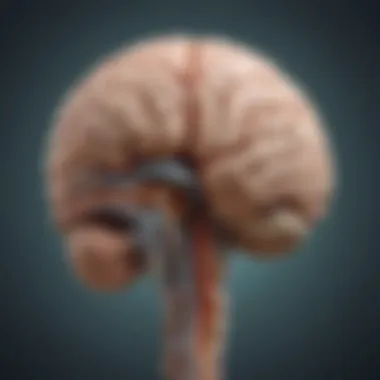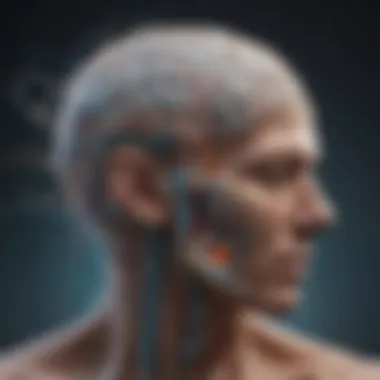Understanding the Amygdala's Impact on PTSD


Intro
Post-traumatic stress disorder (PTSD) is increasingly recognized for its complexity. Central to understanding this condition is the role of the amygdala, a critical structure within the brain. The amygdala processes emotions and influences behavior. It plays a vital role in responding to threatening stimuli. PTSD often arises after an individual experiences or witnesses a traumatic event. In this context, the amygdala's function becomes essential to explore, particularly in terms of how it affects emotional responses and memory consolidation.
The implications of understanding the amygdala's role in PTSD are broad. As we dissect these mechanisms, we may uncover new approaches for treatment and support for those affected by this disorder. This article aims to elucidate the connection between the amygdala and PTSD, offering insights not only into neurobiology but also into potential therapeutic avenues to mitigate the impact of trauma.
Research Overview
Summary of Key Findings
Research has illuminated several crucial aspects of the amygdala's interaction with PTSD. Studies indicate that the amygdala becomes hyperactive in individuals with PTSD. This hyperactivity relates to an exaggerated fear response. On the flip side, there is also a reduction in connectivity with the prefrontal cortex. This region is responsible for rational thought and regulation of emotional responses.
Key findings include:
- Amygdala Hyperactivity: Enhanced responsiveness to trauma-related cues leads to increased anxiety and emotional dysregulation.
- Reduced Prefrontal Regulation: Impaired communication with the prefrontal cortex results in decreased inhibitory control over fearful responses.
- Memory Consolidation: The amygdala's role in emotional memory formation highlights its impact on how traumatic memories are stored and retrieved.
Relevance to Current Scientific Discussions
The discourse around PTSD is evolving. Understanding the amygdala's function is pertinent to many fields. For instance, psychology, neuroscience, and psychiatry are investing more interest in neurobiological underpinnings. This shift parallels an increasing awareness of the broader implications of trauma on mental health. Researchers are now looking into how targeted therapies can be designed. For example, techniques such as exposure therapy may utilize the amygdala's role in emotional processing.
The findings regarding the amygdala also resonate with discussions about integrated approaches to treatment. By combining traditional methods with neuroscience insights, a more holistic understanding of trauma can develop, ultimately benefiting those affected by PTSD.
Methodology
Research Design and Approach
The exploration of the amygdala's relationship with PTSD relies on multidisciplinary approaches. Various studies employ qualitative and quantitative methods to derive comprehensive insights. Neuroimaging techniques, such as functional magnetic resonance imaging (fMRI), are prominent in this research. These technologies facilitate real-time observation of the brain's response patterns.
Data Collection and Analysis Techniques
Data is often collected through controlled studies involving individuals diagnosed with PTSD. Participants may undergo fMRI scans while engaging in tasks that provoke emotional responses. This setup allows researchers to measure the amygdala's activity as well as its interaction with other regions, such as the hippocampus and prefrontal cortex.
Additionally, behavioral assessments and self-report questionnaires contribute to understanding each individual's emotional landscape. Analyzing this data helps in identifying commonalities and variations in responses, painting a broader picture of PTSD's complexity.
Through careful consideration of these factors, the research sheds light on the mechanisms at play, offering the possibility of informed and targeted interventions in the treatment of PTSD.
Foreword to the Amygdala
The amygdala is a small, almond-shaped cluster of nuclei located deep within the medial temporal lobe of the brain. It plays a critical role in processing emotions, particularly those related to fear and reward. Understanding the amygdala's functions is essential in the context of post-traumatic stress disorder (PTSD), as it helps illuminate how emotional responses to trauma are developed and maintained.
Research has shown that the amygdala is involved in various aspects of emotional behavior and physiological responses. Some key points of its significance include:
- Emotional Processing: The amygdala is central to interpreting emotional stimuli. It helps generate immediate responses, particularly to threats. This quick processing can be crucial for survival, but in PTSD, it may also lead to maladaptive responses.
- Learning and Memory: The amygdala interacts significantly with other brain areas, such as the hippocampus, to encode emotional memories. This aspect is vital for understanding how traumatic experiences can leave lasting emotional imprints.
- Regulating Emotional Responses: The amygdala influences how emotions are regulated and expressed. Its dysfunction can lead to inappropriate emotional responses, creating challenges for those suffering from PTSD.
The examination of these elements provides insights into the possible dysregulation associated with PTSD and sets the stage for deeper analysis.
Anatomical Overview
Anatomically, the amygdala is comprised of several parts, including the lateral, basal, and central nuclei. Each region has distinct roles in processing different types of information.
- Lateral Amygdala: This area is primarily responsible for receiving sensory input regarding emotional stimuli. It connects to various sensory areas of the brain, making it crucial for the initial assessment of emotional significance.
- Basal Amygdala: It plays a role in associating emotional responses with contextual information. It helps to interpret threats based on learned experiences.
- Central Amygdala: This nucleus modulates output to various brain regions, influencing physiological responses such as hormonal secretion and autonomic nervous system activation.
This anatomical arrangement enables the amygdala to function efficiently within the wider brain network, contributing to complex emotional and behavioral responses.
Functional Significance


The amygdala's function extends beyond simple emotional processing. In the context of PTSD, understanding its functional significance provides important insights into how individuals experience and interpret trauma. Here are some critical aspects:
- Fear Conditioning: The amygdala facilitates fear conditioning, where neutral stimuli become associated with fearful events. This process is central in explaining why specific triggers can evoke strong emotional reactions in PTSD patients.
- Integration of Sensory Input: The amygdala integrates sensory information to evaluate emotional significance rapidly. This ability allows an individual to make quick decisions in potentially dangerous situations. However, in PTSD, this rapid response can become hyperactive, leading to excessive fear responses even in safe contexts.
- Emotion and Cognition: The amygdala communicates with the prefrontal cortex, which is involved in decision-making and rational thought. This connection is vital for emotional regulation. Dysregulation between these areas can contribute to the emotional disturbances common with PTSD.
Understanding Post-Traumatic Stress Disorder
Understanding post-traumatic stress disorder (PTSD) is crucial to grasp how the amygdala operates within the parameters of emotional response and memory processing in individuals who have experienced significant trauma. PTSD offers insights into how trauma can disrupt mental health and reveals the underlying neurobiological mechanisms that affect emotional well-being. Since the amygdala is central to processing fear and emotional responses, its role in PTSD cannot be overstated.
This section will explore vital aspects such as defining PTSD, recognizing symptoms and diagnostic criteria, and examining the epidemiology of this disorder. By analyzing these components, we can appreciate the multifaceted nature of PTSD and its connection to the amygdala.
Defining PTSD
Post-traumatic stress disorder is a mental health condition triggered by firsthand experiences or witnessing traumatic events. It is categorized as an anxiety disorder that can severely impair daily functioning. Key events that can lead to PTSD include combat exposure, sexual assault, childhood abuse, accidents, and natural disasters.
For a diagnosis, individuals must have caused significant emotional distress, impacting their quality of life. Understanding the intricacies of PTSD helps develop suitable interventions, which are often based on the recognition of the amygdala's involvement in the condition.
Symptoms and Diagnostic Criteria
PTSD encompasses a range of symptoms that can manifest differently among individuals. Symptoms are broadly categorized as follows:
- Re-experiencing: This can involve intrusive thoughts, flashbacks, or nightmares about the trauma.
- Avoidance: Individuals may try to avoid reminders of the traumatic event, leading to social withdrawal and restricted emotional responses.
- Negative Alterations in Cognition and Mood: This includes feelings of hopelessness, persistent negative emotions, and difficulty experiencing positive emotions.
- Alterations in Arousal and Reactivity: Individuals might experience heightened alertness, irritability, or sleep disturbances.
To be diagnosed with PTSD, these symptoms must persist for more than a month and cause significant distress or impairment. Clinicians usually refer to the DSM-5 criteria for consistency in diagnosis.
Epidemiology of PTSD
PTSD affects a substantial portion of the population, with varying prevalence rates influenced by factors such as location, occupation, and demographics. Studies indicate that up to 8% of the general population may experience PTSD at some point in their lives. Specific groups, such as military veterans, may have even higher rates of incidence. Furthermore, factors like gender, socioeconomic status, and community support play essential roles in the development of PTSD.
Research shows:
- Male veterans tend to have a higher prevalence of PTSD compared to their civilian counterparts.
- Women are at a greater risk of developing PTSD following trauma exposure but tend to show resilience when adequate support is present.
The connection between these epidemiological patterns and the neurobiological underpinnings of PTSD, particularly involving the amygdala, opens avenues for targeted therapies. Understanding these aspects not only enlightens clinicians but also provides individuals with a clearer perspective on their experiences in relation to PTSD.
Neurobiological Mechanisms of PTSD
Understanding the neurobiological mechanisms of post-traumatic stress disorder (PTSD) is essential for grasping how trauma affects the brain. This section explores the chemical and structural changes that occur in the brain after exposure to traumatic events. By examining these mechanisms, we gain insight into the biological underpinnings that may lead to persistent psychological symptoms in individuals with PTSD.
Neurotransmitters Involved
Neurotransmitters are crucial for communication in the brain. In the context of PTSD, specific neurotransmitters play significant roles in how an individual responds to stress and trauma.
- Norepinephrine: This neurotransmitter is involved in the body’s fight or flight response. Increased norepinephrine levels have been linked to hyperarousal symptoms common in PTSD, such as heightened startle responses and irritability.
- Cortisol: Known as the stress hormone, cortisol levels often become dysregulated in individuals with PTSD. Normal cortisol release helps to manage stress, but chronic stress can lead to a toxic cycle of hormonal imbalance. This dysregulation may further exacerbate trauma-related memories and symptoms.
- Serotonin: This neurotransmitter is linked to mood regulation, and its dysregulation is often observed in PTSD, leading to symptoms of depression and anxiety. Addressing serotonin levels can be crucial in treatment, especially through pharmacological interventions.
- Dopamine: In PTSD, dopamine levels can also be affected, which may influence motivation and reward processing. Research is ongoing to understand how these changes impact recovery from trauma.
These neurotransmitters collectively create a complex biochemical landscape that dictates an individual’s emotional and behavioral responses to traumatic experiences.
Brain Structures Associated with PTSD
Several brain structures are fundamental to the understanding of PTSD. Their interactions shape how trauma is processed and stored.
- Amygdala: As previously discussed, the amygdala is central to the processing of emotions, particularly fear. Hyperactivity in the amygdala during traumatic recall can lead to persistent fear responses often experienced in PTSD.
- Hippocampus: This brain region plays a crucial role in memory formation and retrieval. In individuals with PTSD, studies show a reduction in hippocampal volume, which may contribute to difficulties in differentiating between past and present threats.
- Prefrontal Cortex: The prefrontal cortex is involved in decision-making and emotion regulation. Dysregulation in this area can hinder the ability to process traumatic memories rationally, making it challenging for individuals to cope with their experiences.
- Anterior Cingulate Cortex: This region is vital for attentional control and emotional regulation. Dysfunction here may lead to impaired cognitive processing of emotional experiences, which is often seen in PTSD.
Overall, the interactions between these brain structures reveal how trauma can affect cognitive and emotional health. Understanding these neurobiological mechanisms offers a pathway toward improved treatment options for those suffering from PTSD.
"Neurobiological pathways in PTSD suggest that the disorder is not merely psychological; it is deeply embedded in brain function and structure, necessitating a multifaceted approach to treatment."


Recognizing these intricate mechanisms provides an important foundation for developing targeted therapies and interventions aimed at alleviating symptoms and fostering recovery.
Amygdala Activation and Trauma Response
The amygdala's activation is a fundamental aspect in understanding trauma response, especially in the context of post-traumatic stress disorder (PTSD). This small, almond-shaped cluster of nuclei located deep within the temporal lobes engages in processing emotions, particularly fear. When individuals experience traumatic events, the amygdala's response can lead to a cascade of neural and hormonal reactions that can overwhelm the brain's capacity for emotional regulation. Therefore, the amygdala's functioning is crucial for comprehending how individuals react to fear-inducing stimuli and how these reactions may contribute to PTSD.
Neural Pathways Related to Fear
The neural pathways associated with fear involve multiple interconnected regions within the brain, centering primarily around the amygdala. When a threat is perceived, sensory information travels through the thalamus to the amygdala before reaching the cortex, which is responsible for higher-order processing. This rapid transmission enables a quick response to perceived danger, often referred to as the fight-or-flight response.
Key components of this neural pathway include:
- Thalamus: Serves as the relay station for sensory information.
- Amygdala: Activates emotional responses and fear behaviors.
- Hypothalamus: Triggers the release of stress hormones, influencing physiological reactions.
- Prefrontal Cortex: Modulates the response and engages in decision-making.
This circuitry illustrates how the amygdala operates as an alarm system, ensuring survival. However, in individuals with PTSD, this system may become dysregulated. Hyperactivity of the amygdala is often observed in these cases, leading to persistent fear responses and heightened sensitivity to trauma-related cues. Understanding these pathways is critical for developing effective interventions for PTSD.
Role of the Amygdala in Emotional Memory
The amygdala plays a significant role in the encoding and retrieval of emotional memories, particularly those linked to fear. It enhances the memory formation of emotionally charged experiences, which is essential for survival. When a traumatic event occurs, the amygdala's activation solidifies the memory, influencing behavior in similar future situations.
The processes involved include:
- Encoding: Fearful experiences are encoded more robustly due to amygdala activity, making these memories vivid.
- Storage: The amygdala interacts with the hippocampus to regulate how memories are stored, impacting how one recalls past trauma.
- Retrieval: The emotional intensity of memories can lead to flashbacks and intrusive thoughts, common symptoms in PTSD.
The heightened reactivity of the amygdala in PTSD reflects its role as an emotional memory hub, amplifying trauma-related memories and contributing to the disorder's persistence.
In sum, the amygdala's activation during trauma responses is pivotal in shaping how individuals experience fear and process memories. This understanding underlines the relevance of addressing amygdala dysregulation in developing therapeutic strategies for PTSD.
Dysregulation of the Amygdala in PTSD
In the context of post-traumatic stress disorder (PTSD), the dysregulation of the amygdala plays a central role in how individuals process and respond to traumatic experiences. The amygdala, known for its involvement in emotional processing, can become overly reactive. This heightened activity can lead to persistent and intense fear responses, a hallmark of PTSD. Understanding this dysregulation is crucial, as it highlights both the neurobiological underpinnings of the disorder and potential pathways for intervention.
Dysregulation of the amygdala can contribute to the development of various PTSD symptoms, including hyperarousal, intrusive thoughts, and emotional numbing. Individuals suffering from PTSD often report heightened anxiety and exaggerated startle responses. These symptoms correlate with increased amygdala activity, suggesting that interventions aimed at normalizing its function could alleviate distress.
Hyperactivity and Its Implications
The hyperactivity of the amygdala seen in PTSD can lead to a cascade of implications for affected individuals. Research indicates that during traumatic events, the amygdala may engage in excessive signaling, creating strong fear memories. This process activates the hypothalamic-pituitary-adrenal (HPA) axis, leading to the overproduction of stress hormones like cortisol. Elevated cortisol levels, in turn, may affect other brain regions, including the hippocampus and the prefrontal cortex, which are crucial for memory processing and emotional regulation.
Hyperactivity can also interfere with the ability to distinguish between safe and threatening environments. This causes a condition known as 'hypervigilance,' where individuals remain constantly alert to potential danger. Over time, this state can contribute to chronic anxiety, social withdrawal, and impaired functioning. Therefore, understanding the nuances of amygdala hyperactivity is essential when considering treatment options that aim to restore balance within the brain's emotional circuits.
Effects on Emotional Regulation
The dysregulation of the amygdala exerts a significant influence on emotional regulation in those with PTSD. An overactive amygdala diminishes the capacity for emotional processing, resulting in difficulties in managing negative feelings such as anger or sadness. This can contribute to an overall sense of emotional instability.
Furthermore, effective emotional regulation typically involves a healthy interaction between the amygdala and the prefrontal cortex. However, when the amygdala is dysregulated, this communication can falter. Reduced executive functioning from the prefrontal cortex limits the person's ability to apply strategies for managing emotions or interpreting situations more rationally. Thus, individuals may resort to avoidance behaviors or aggression, which further exacerbate their emotional difficulties.
Recognizing the intricate relationship between the amygdala's dysregulation and emotional responses in PTSD is critical for developing psychological interventions. Therapies that focus on enhancing cognitive control over emotional responses, such as cognitive behavioral therapy (CBT), can prove beneficial. By re-establishing functional interactions between these brain regions, individuals may improve their emotional regulation skills and overall quality of life.
Amygdala and Its Interactions with Other Brain Regions
The amygdala does not function in isolation; its interactions with other brain regions are crucial to understanding its role in emotional processing and PTSD. By examining these connections, we can appreciate how the amygdala communicates with structures like the hippocampus and the prefrontal cortex. This interplay is vital because it influences not just emotional responses but also memory and decision-making processes. The complexity of these interactions can provide insight into how dysregulation in these pathways may contribute to the persistence of PTSD symptoms.
Hippocampus and Memory Processing
The hippocampus is essential for forming and recalling memories, particularly those related to specific events. It interacts closely with the amygdala to encode emotional memories. When a person experiences trauma, the amygdala activates, signaling the hippocampus to help store that memory with emotional weight. This process can either aid in resilience by allowing individuals to learn from their experiences or contribute to distress when memories are overly charged with negative emotions.


"The maladaptive responses to traumatic memories, when the amygdala’s influence overrides that of the hippocampus, is commonly observed in PTSD individuals."
The dysfunctional interaction can lead to fragmented or intrusive memories in those with PTSD. In simple terms, the amygdala’s hyperactivity during trauma can inhibit the hippocampus's ability to contextualize these memories properly. Thus, victims may relive the experience without rational understanding, which perpetuates their distress.
Prefrontal Cortex and Decision Making
The prefrontal cortex plays an essential role in higher cognitive functions such as decision-making, impulse control, and emotion regulation. Its relationship with the amygdala is significant, especially in the context of PTSD. When the amygdala is overactive, it can impair the prefrontal cortex's ability to manage emotions and make reasoned decisions. This is concerning because effective decision-making relies on a harmonious balance between these regions.
The prefrontal cortex can exert top-down control over the amygdala, helping to mitigate anxiety and fear responses. However, when the signaling from the amygdala is too intense, it can overwhelm the prefrontal cortex, leading to heightened anxiety, erratic behavior, and difficulty in regulating emotions. This dysregulation is a common symptom in individuals with PTSD and calls for targeted therapeutic strategies to improve the functionality of this brain circuit.
Understanding these interactions sheds light on the neural underpinnings of PTSD. The balance between the amygdala, hippocampus, and prefrontal cortex is a critical factor in managing emotional responses to trauma.
Implications for Treatment and Therapy
In addressing post-traumatic stress disorder (PTSD), understanding the implications of treatment and therapy in relation to the amygdala's role is paramount. The amygdala significantly influences emotional responses to trauma, thereby guiding therapeutic approaches. Treatments aimed at modulating amygdala activity can lead to improved outcomes for those suffering from PTSD. This section discusses key therapeutic strategies, their benefits, and important considerations.
Cognitive Behavioral Therapy (CBT)
Cognitive Behavioral Therapy (CBT) is one of the most prominent therapies for PTSD. It focuses on altering distorted thinking patterns and behaviors that perpetuate the disorder. The effectiveness of CBT is closely linked to its impact on the amygdala's function.
During therapy, a patient often confronts traumatic memories in a controlled environment. This exposure can help the patient to desensitize the amygdala's heightened response to threats. By gradually facing traumatic memories, individuals can learn to reprocess these events, reducing anxiety and hyperarousal that characterizes PTSD.
Moreover, CBT incorporates techniques like cognitive restructuring, which seeks to replace negative thought patterns with more balanced perspectives. Doing so may promote healthier emotional regulation, assisting the amygdala in functioning optimally. The overall effect can lead to increased coping abilities, enabling patients to respond more adaptively to stressors.
Pharmacological Interventions
Pharmacological interventions are another critical aspect of PTSD treatment. Commonly prescribed medications include selective serotonin reuptake inhibitors (SSRIs) such as Sertraline and Paroxetine. These medications aim to modify neurotransmitter levels, particularly serotonin, impacting mood and emotional responses.
Research shows these drugs can help decrease amygdala hyperactivity, reducing symptoms like intrusive thoughts and hypervigilance. However, it is vital to consider that pharmacotherapy may not work for everyone, and side effects can occur. A careful assessment of individual patient needs is necessary for effective treatment planning.
Combination therapy, integrating CBT with pharmacological treatments, might offer more substantial benefits. This approach ensures that both the psychological and biological aspects of PTSD are addressed, promoting a more comprehensive recovery process.
Ultimately, the implications for treatment and therapy concerning the amygdala highlight the need for tailored strategies that consider individual differences in neurobiology, experience, and response to treatment.
"The integration of psychological and pharmacological approaches represents a growing frontier in understanding and treating PTSD effectively."
Understanding the complex interplay between therapeutic modalities and amygdala function lays the groundwork for future research and improved treatment protocols.
Future Directions in Research
Emerging Therapies and Innovations
New therapeutic approaches are essential in addressing the complex nature of PTSD. Recent developments focus on integrating technology with traditional treatments. For instance, virtual reality therapy is increasingly popular. This method allows therapists to recreate traumatic scenarios in a controlled environment.
Furthermore, advancements in pharmacotherapy show promise. Research on ketamine, for example, is gaining attention for its rapid effects in reducing PTSD symptoms. It works differently than conventional medications, and its potential to aid those resistant to standard treatments is noteworthy.
Benefits of exploring new therapies include:
- Greater effectiveness for diverse patient needs
- Reduced side effects compared to existing treatments
- Formation of personalized treatment plans based on brain function
Considering these advancements, ongoing clinical trials will be crucial in validating and refining these innovative therapies. Researchers must keep in mind ethical considerations and the need for comprehensive training for practitioners in these emerging areas.
Longitudinal Studies on PTSD and Brain Function
Longitudinal studies are vital for understanding how PTSD manifests over time and how the amygdala's function may change. These studies track individuals at various stages after experiencing trauma. They provide insights into the long-term effects of trauma on brain structure and function.
Key aspects to look for in longitudinal studies include:
- Changes in amygdala activation patterns
- The relationship between amygdala dysregulation and symptom severity over time
- Correlations with other brain regions, such as the prefrontal cortex and hippocampus
The analysis of such studies can reveal important trends and patterns. This may lead to improved diagnostic methods and potential preventive measures for PTSD. Additionally, understanding the long-term impacts of treatment can help clinicians develop better strategies for patient care.
In summary, future research directions are not only necessary but pivotal in advancing our understanding and treatment of PTSD. Both emerging therapies and longitudinal studies will contribute significantly to this field, resulting in potentially more effective and individualized care for individuals affected by trauma.



